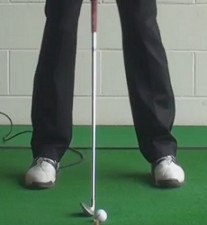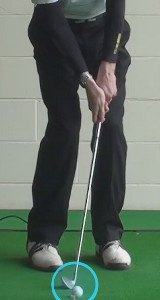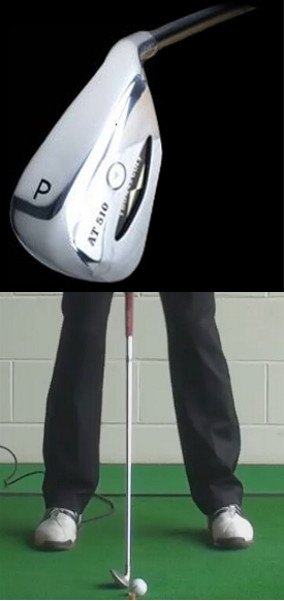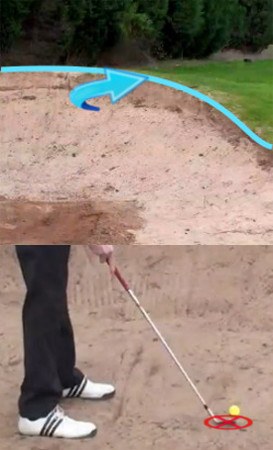
Like its siblings the gap, sand and lob wedges, the pitching wedge is an extremely versatile golf club.
With 45-50° of loft, the pitching wedge hits the ball farther and lower than the other wedges. That makes it valuable on windy days, especially when a shot with a higher lofted wedge would be vulnerable to the breeze.
With less loft and bounce (bulge on the club's sole) than a sand wedge, the pitching wedge is a good option on long shots from greenside bunkers. If you've got more than 40 feet to the flag, plenty of green to work with and sand that isn't too thick or fluffy, consider the pitching wedge.

The pitching wedge is most often used for chips and pitch shots around the green, especially from short grass. It's easy to vary the height of shots with the pitching wedge by simply adjusting the position of the ball in your stance. For most shots, play the ball in the center of your stance. Hit it higher by moving the ball toward your left foot (for right-handers); move it closer to the right foot for a lower trajectory.
You may also open the face of a pitching wedge at address, which effectively increases the loft for higher, softer shots.

Pitching Wedge, a Handy Tool for Many Shots
The rules of golf limit you to 14 clubs in your bag during any given round. While you can obviously change clubs between rounds, you are not allowed to alter your set between the first tee and the last green. The 14 clubs you start with are the 14 you will have to end with, so it is important to make the most of each spot in your set. Too many golfers make the mistake of thinking that certain clubs can only handle specific kinds of shots. By opening yourself up to a more creative view of the game, you can maximize the value you get out of each slot.
In this article, we are going to focus specifically on the pitching wedge. This is one of the most versatile clubs in your bag, as it is capable of playing shots in a number of different situations. You might think first about hitting full shots from 100 – 125 yards when you think about the pitching wedge, but there is far more to this club than just that one role. Hopefully, by the end of this article, you will see the many roles that this club is capable of filling within your game.
One of the nice things about focusing some of your practice efforts on the pitching wedge is the fact that this is a relatively easy club to hit. Even making a full swing with your pitching wedge is a simple task compared to hitting a long iron, or even your driver. Too many beginning golfers focus on the long clubs when it is really the short clubs which form the foundation of a solid game. If you can refine your skills with your wedges and the putter first, you will always have that to fall back on even when your long clubs don't cooperate. While the rest of your golfing buddies are standing on the range hitting their drivers, go your own way and work on your short clubs. In the long run, you will likely be the one recording the lowest scores round after round.
As you read through the rest of this article, keep in mind that you can hit many of the same shots with a sand wedge that you are learning how to hit with a pitching wedge. The same can be said for your lob wedge. So, by learning a variety of shots which can be played with the pitching wedge, you will actually be learning shots that can be varied on demand simply by switching down to one of your other wedges. In the end, you will be left with a long list of shots you can play from inside 100 yards or so. Golf is always easier when you have options, so expanding your 'portfolio' of shots is a powerful way to improve.
All of the content below is based on a right-handed golfer. If you happen to play left-handed, please take a moment to reverse the directions as necessary.

The Basic Full Swing Pitching Wedge
To get started, it makes sense to look at the full swing shots you can hit with your pitching wedge. Once we are done with this topic, we will gradually move closer and closer in toward the green. Basically, you are going to swing your pitching wedge the same way you would swing any other club in your bag. You certainly don't want to make any dramatic changes to your mechanics from one club to the next.
With that said, there are some full swing points you should keep in mind which are specific to your pitching wedge. Those points are listed below.
- Play the ball in the middle of your stance. Ball position is an important point to get right when setting up to play any kind of shot. When it comes to making a full swing with your pitching wedge, you want to start with the ball perfectly in the middle of your stance. You may decide to move it forward or back slightly when trying to alter your ball flight, but the middle of the stance is perfect for a 'stock' shot. Golf is all about mastering the details of your game, and this is one of the most important details of all.
- Make a compact backswing. There is no reason to make a long swing when hitting your pitching wedge. This is a shot which should be about control first and foremost. A long swing is only going to cause you to lose control over the shot, so resist the temptation to swing the club way up over your head. Keep the swinging action compact and controlled, and maintain your balance nicely at all times.
- Hit down through impact. The pitching wedge in your hands likely has 45* - 48* of loft. What does that mean? You don't need to do anything to help the ball get off the ground. The loft of the club is going to do the work, and it needs no help from you. Rather, your job is to hit down through the ball aggressively at impact. If you hit down, backspin will be imparted on the ball and it will climb high into the sky on its way toward the target. Countless amateur golfers attempt to 'scoop' the ball at impact, an impulse that makes it nearly impossible to strike solid shots. Forget about scooping the ball and hit down each and every time. Even making just this one change could lead to dramatically improved results.
- Take dead aim. When standing over the ball with a pitching wedge in your hands, you should be thinking aggressively about hitting the shot in close to the target. This is not a time for a conservative game plan or cautious approach. When you have a yardage which calls for your pitching wedge, you should be in a 'flag hunting' frame of mind. You are unlikely to hit your pitching wedge dramatically off line, and it should be relatively easy to hit the shot this right distance. It is wise to be conservative on longer shots, but now is not the time for such thinking. Fire away and do your best to get the ball down in just two shots from this location.
Ideally, you will have plenty of confidence in your ability to hit full swing pitching wedge shots on the course. This is one of the easier shots you will face, as the short overall length of the club means you have a greater margin for error than with a long iron or driver. As long as you execute solid fundamentals, you should have little trouble sending the ball toward the target time after time.

Living Up to Its Name
It only stands to reason that you should be able to hit nice pitch shots with your pitching wedge. After all, the word 'pitch' is right there in the name of the club. And it is true – when used properly, the pitching wedge is a great weapon for medium-length pitch shots in the 30 – 40-yard range. However, not all shots of this length will be a good match for the pitching wedge, as some will need to be played with a sand wedge or even a lob wedge. Knowing when to reach for your pitching wedge is a big part of handling these shots properly.
When you find your ball resting somewhere around 30 yards from the hole, the first thing you need to do is assess the lie. Are you sitting on short grass, or is the ball down in the rough? If you are in the rough, you can pretty much exclude the pitching wedge right away – you are going to need more loft to negotiate the shot successfully. If you are in the fairway, however, you can keep the pitching wedge in mind as you assess the rest of the situation.
The next aspect to consider is the path between your ball and the hole. To use a pitching wedge, you are going to need plenty of room with which to work. In other words, you need to have space to land the ball well short of the hole so it can bounce and roll out until it comes to a stop. Pitching with a pitching wedge is going to lead to a flat shot with plenty of run out, meaning this will only work when you have enough space available. If the hole is cut barely onto the edge of the green in front of you, the better play will be to use more loft in order to stop the ball quickly.
Should you happen to find that you have a good lie in the fairway and plenty of green to work with, you can settle on the pitching wedge as your club of choice for this shot. With your club selection made, you can now take your stance and hit the shot. Use the tips below to execute your technique properly for this play.
- Set up open to the target. To play this type of pitch shot, you are going to start by opening your stance slightly to the target. This should be similar to the kind of stance you use while chipping the golf ball. An open stance will allow you to swing slightly across the ball at impact, which is exactly what you need to do. Also, this open stance will give you a nice view of the target, which helps some players feel more comfortable at address.
- Middle of your stance. Play the ball in the middle of your stance when hitting a mid-range pitch with your pitching wedge. You don't want to hit down too steeply on this kind of shot, but you don't want to scoop the ball either. By using a middle ball position, you can sweep the ball off the turf and send it on its way.
- Choke down on the club. As is usually the case with any kind of short game shot, you want to choke down on the grip of your pitching wedge slightly in order to gain control. If you were to keep your hands up at the top of the grip, you would likely have trouble controlling your distance, and it may be tough to make clean contact as well. Get used to playing these shots with your hands a couple of inches down the grip and your results should quickly improve.
- Keep your head still. This is the kind of shot that often tempts players to look up early. If you are anxious to see where the ball is going to go, you might look up early as a result. When you look up, your shoulders and the rest of your upper body will come out of the shot, and your quality of contact will suffer. Don't make this mistake. Resist the temptation to look up early and keep your head down all the way through impact. As long as you are disciplined enough to keep your head still, you should find it easy to strike the ball cleanly time after time.
Before you pull your pitching wedge from the bag out on the course to hit this type of shot, be sure to work on it in practice. Many golfers are surprised at how far the ball will travel with just a small swing when they first try this shot. Get that learning curve out of the way in practice so you can be nicely dialed in when you hit the links.

Short Chip Shots
In this section, we are going to address the short chip shots you will hit with your pitching wedge from just off the wedge of the putting surface. When it comes to these kinds of shots, you don't actually have to be on the short grass to use your pitching wedge – playing from the rough will work here as well. This type of shot is highly effective and can help you get up and down from a variety of situations. If you are tired of making bogeys after just barely missing the green with your approach shot, learn how to use your pitching wedge effectively in this spot. You will start to chip the ball closer after a bit of practice, and many of those bogeys will turn into pars.
Some of the mechanics you use when chipping from just off the edge of the green will match up with your pitching technique, but there are some subtle differences. The following step-by-step process will walk you through how to play this shot with a pitching wedge.
- Before walking up to the ball to take your stance, start by picking out a target line and a landing spot. Your landing spot should be based on the distance you expect the ball to travel after it lands on the green. A big part of the challenge with this kind of shot is picking the right landing spot based on the bounce and roll that you will experience. Pick the right landing spot and the rest of the shot just comes down to execution.
- Now that you have your landing spot in mind, take your stance and orient the face of the club to point perfectly at your spot. While the club face will be pointing at the landing spot, your stance should be open – just as it was when you were pitching the ball. When it comes time to make the swing, be sure to swing along your foot line in order to come across the ball slightly from outside-in at impact. This type of swing path will help to pop the ball up into the air, and it will give you more control over the speed of the shot.
- With the pre-shot details out of the way, you are ready to swing. Your hand should be choked down slightly on the grip, and your eyes should be on the ball (of course). Instead of using some hand action as you would have done when pitching, you are going to keep your hands and wrists almost entirely out of this shot. Instead, you are going to rock your shoulders just as you would do when putting. Use your shoulders to move the club and brush the ball off of the turf and toward the hole.
- As a good rule of thumb, you should try to keep your head and eyes down on the spot where the ball had been resting until the ball has landed on the green. This habit will help you keep your upper body down throughout the swing, which is critical if you are going to control these chips.
As you practice this shot, be sure to work on the skill of picking the right landing spot in addition to the actual action of swinging the club. This is a pretty easy shot when compared to others you need to hit around the course – so picking a good landing spot may be the most challenging part of the process. Spend plenty of time on this basic shot during practice to build your short game confidence prior to your next round.

The Occasional Bunker Shot
The three types of shots listed above – a full swing, a mid-length pitch, and a short chip – are going to make up the majority of the shots you hit with your pitching wedge. However, the versatility of this club is not finished quite yet. From time to time, you might actually find an opportunity to use your pitching wedge when your ball is in a greenside bunker. This will not be a frequently occurrence, as most bunker shots are best handled with your sand wedge. However, when the conditions are right, it is helpful to know how to use your pitching wedge to blast the ball out of the sand and onto the green.
In order to know when the time is right to reach for your pitching wedge in order to hit a bunker shot, you will want to look for the following conditions.
- A long shot. You really only need to consider the pitching wedge when you are playing a long bunker shot across the green. On shorter shots, you will want the loft offered by a sand wedge or lob wedge. When the shots become longer, however, it can be difficult to cover the necessary distance with so much loft on the club. This is where the pitching wedge can come in handy.
- A low lip. Since you won't be using as much loft, it is important to look for a low lip in front of you. Deep bunkers aren't a great opportunity to use the pitching wedge, as you will struggle to hit the ball high enough to get onto the green. Remember, the first goal of every bunker shot is to get out of the sand and back onto the grass, so never take a chance on hitting the ball too low.
- Firm sand. The bottom of your pitching wedge features a flatter design than your sand wedge and lob wedge. That flat design – or low bounce – means the club is going to naturally dig into the sand as you swing. Should you try to play a shot from soft sand with your pitching wedge, you will find that the club digs in and the shot comes up short. You should really only consider this method when you have firm sand under your feet.
As you can see, the pitching wedge is one of the most versatile clubs in your bag. From full swings to short chips and even bunker shots, the pitching wedge can help you get the ball close to the hole. This club is not going to hit the ball for you, however, so remember to put in some practice time on these various shots before you head out for your next round. Good luck!






